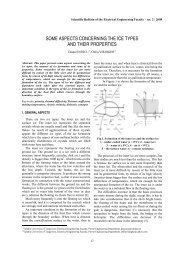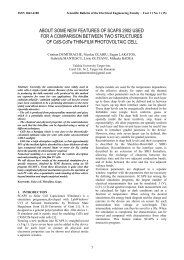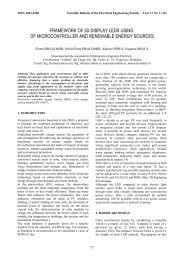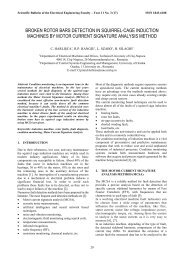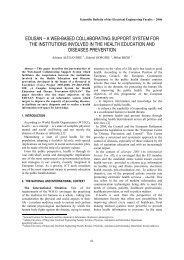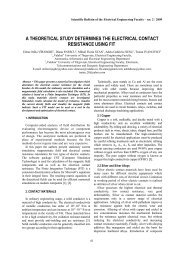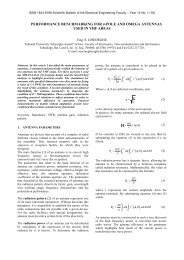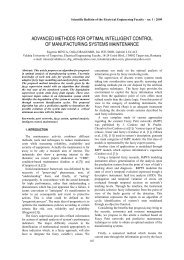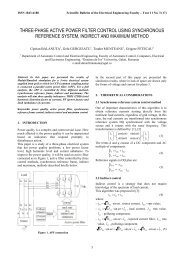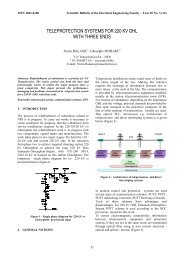considerations related to face-to-face and web-based learning ...
considerations related to face-to-face and web-based learning ...
considerations related to face-to-face and web-based learning ...
Create successful ePaper yourself
Turn your PDF publications into a flip-book with our unique Google optimized e-Paper software.
Scientific Bulletin of the Electrical Engineering Faculty – 2008– Learn through network (Internet) P↔N(etwork);– Learn through network <strong>and</strong> persons (CSCL):P←N→P.Romanian educational system illustrates the first twosteps. Till now, the <strong>learning</strong> <strong>to</strong> use the ICT was supportedby the Ministry of Education through various actions suchas: the presence in all the initial <strong>and</strong> in-service trainingprograms of ICT courses, the project: “Educating for anOpen Society”, “InfoEducatie” Project, “P&G Project:Give our Children an Extra Chance in Life” etc.Computer Assisted Instruction (CAI) represents a<strong>learning</strong> methodology that Romanian specialists ineducation wrote about even before 1990. In the fieldliterature this concept represents a buzz word about whichis more “said than done”. In practice, the use of computeris inserted in certain moments of the classical lesson for:– simulation of certain phenomenon;– creation of test problems;– differentiated work;– synthesis activities;– development of didactic games.While Intelligent Tu<strong>to</strong>ring Systems (ITS) are verylittle represented in the Romanian education, the useof Internet as a source of information is an informalreality which is more <strong>and</strong> more considered in theformal education. Students develop capabilities ofusing the Internet as a source of information ininformal settings. As this is a very popular activity <strong>and</strong>youngsters nowadays, their motivation represents achallenge for schools which must adapt <strong>to</strong> this need.The use of Internet as a source of information inschools implies the training of teachers in generalInternet use skills <strong>and</strong> the development ofmethodological coherent schemes that integrateInternet sources in a formative way.3. THE WEBQUEST TECHNIQUEIn this respect, an interesting initiative was therunning of a course, for three editions, by Babes-Bolyai University, Science of Education Department<strong>and</strong> Valahia University Targoviste, on the use of ICTin education, specifically, on the WebQuest technique.The training was made in the frame of the SocratesComenius 2.1 European Project called “Think,Construct <strong>and</strong> Communicate. ICT as a VirtualLearning Environment” (106469-CP-1-2002-1-ES-COMENIUS-C2.1.,http://cfievalladolid2.net/think<strong>web</strong>). The main purposeof this project was <strong>to</strong> promote the cooperation betweendifferent European teaching <strong>and</strong> educational entities(Infant School, Secondary School, High School,Teacher Training <strong>and</strong> University) by means of theWorld Wide Web <strong>to</strong> produce <strong>and</strong> disseminate aWebQuest <strong>based</strong> course with the objective ofstimulating the didactic use of the Web. Eightinstitutions from five countries (Spain, Romania,Finl<strong>and</strong>, Italy <strong>and</strong> Pol<strong>and</strong>) participated in this threeyear project. In Romania, 91 teachers <strong>and</strong> teacherstudents were trained on the use of WebQuest as ameans of collaborative project <strong>based</strong> <strong>learning</strong> <strong>to</strong>ol.Bernie Dodge, the parent of WebQuest(http://<strong>web</strong>quest.sdsu.edu) made the essentialdescription of the technique. He defined a WebQuestas “an inquiry oriented activity in which some or all ofthe information that learners interact with comes fromresources on the Internet, optionally supplementedwith videoconferencing.” (Dodge [2]).The technique starts from the assumption that thereis a questionable educational benefit in having learnerssurfing the net without a clear task in mind, <strong>and</strong> mostschools must ration student connect time severely.Consequently, a WebQuest project is organized arounda specific task <strong>and</strong> the on-line resources are preselectedby the teacher <strong>and</strong> assigned <strong>to</strong> specificactivities within the project.Some other non-critical attributes of a WebQuestrelevant for collaborative <strong>and</strong> constructivist <strong>learning</strong>spaces include (Dodge [2]):– WebQuests are most likely <strong>to</strong> be group activities,although one could imagine solo quests thatmight be applicable in distance education orlibrary settings;– WebQuests might be enhanced by wrappingmotivational elements around the basic structureby giving the learners a role <strong>to</strong> play (e.g., scientist,detective, reporter), simulated persons <strong>to</strong> interactwith via e-mail, <strong>and</strong> a scenario <strong>to</strong> work within(e.g., you have been asked by the SecretaryGeneral of the UN <strong>to</strong> brief him on what ishappening in sub-Saharan Africa this week.)– WebQuests can be designed within a singlediscipline or they can be interdisciplinary. Giventhat designing effective interdisciplinaryinstruction is more of a challenge than designingfor a single content area, WebQuest crea<strong>to</strong>rsshould probably start with the latter until theyare comfortable with the format.After completing a WebQuest, a learner would haveanalyzed a body of knowledge deeply, transformed itin some way, <strong>and</strong> demonstrated an underst<strong>and</strong>ing ofthe material by creating something that others canrespond <strong>to</strong>, on-line or off-line.The obtained results of the WebQuest impact in theclassroom proved that the technique was an importantsource of inspiration for the teachers, a suitable teaching<strong>and</strong> <strong>learning</strong> method <strong>and</strong> a way for integrating Internetin <strong>learning</strong>. One of the greatest gains of the WebQuestimplementation was obtained in pupils’ motivation <strong>and</strong>cooperative work (Gorghiu et all [3]).4. OPEN AND DISTANCE LEARNINGOpen Distance Learning (ODL) has beendeveloped mostly within the higher education <strong>and</strong> inserviceteacher training programs. In the Romanianeducational system, ODL structures are relatively new<strong>and</strong> develop constantly. The ODL educational76
Scientific Bulletin of the Electrical Engineering Faculty – 2008programs exist usually in both a traditional <strong>face</strong>-<strong>to</strong><strong>face</strong><strong>and</strong> distance <strong>learning</strong> form. In fact this tends <strong>to</strong> bean implicit request of the central management.Basically, the ODL system combines the virtualcommunication with students with <strong>face</strong>-<strong>to</strong>-<strong>face</strong> meetings.The virtual communication does not provide a realinteractive <strong>and</strong> collaborative electronic <strong>learning</strong>environment: collaborative synchronous <strong>to</strong>ols such asforums, discussion groups, whiteboard, schemes forspecific argumentation <strong>and</strong> search for a consensus of the<strong>learning</strong> community or, as it would be normal, possibilitiesfor knowledge exploration, simulation of real worldsituations. The <strong>web</strong> is usually used in ODL as a generalinformation delivery space <strong>and</strong> a form of keeping in <strong>to</strong>uchwith the students. The focus here is rather oncommunication then on what is being communicated.Face-<strong>to</strong>-<strong>face</strong> meetings consist of two types ofinteractions: tu<strong>to</strong>rials <strong>and</strong> assisted <strong>learning</strong>. Tu<strong>to</strong>rialsare simply lessons that use the classical means ofteaching, such as synthesis lectures, <strong>and</strong> assisted<strong>learning</strong> is focused on application of knowledge <strong>and</strong>problem solving <strong>learning</strong> situations.Attempting <strong>to</strong> create a real virtual <strong>learning</strong> space, someuniversities in Romania experimentally used variousplatforms (IBM Lotus Learning Management System,Blackboard etc.). In two Socrates Comenius 2.1 EuropeanProjects, Babes-Bolyai University <strong>and</strong> Valahia UniversityTargoviste experimented BSCW (former name – BasicSupport for Cooperative Work, actual name – Be Smart –Cooperate Worldwide) as a virtual cooperation instrumentin delivering specific on-line courses.As example, in the frame of the Project “FISTE - AFuture Way for In-Service Teacher Training AcrossEurope” (118766-CP-1-2004-1-RO-COMENIUS-C21-http://fiste.ssai.valahia.ro) with the overall aim on focusing<strong>to</strong> find new ways of how <strong>to</strong> teach in-service teachers intheir long-life training programs <strong>and</strong> how the teachersthemselves can learn <strong>and</strong> upgrade their knowledge <strong>and</strong>teaching methods by using ICT, 107 Romanian in-serviceteachers were trained <strong>to</strong> integrate the new technologies intraditional training (cooperative platforms, Multimediatechniques, Virtual Reality, videoconference). In thissense, they attended different editions of the on-line course“Integrating ICT in Traditional Training”. The BSCWsystem assured the cooperation <strong>and</strong> collaboration betweenparticipants, allowing them not only <strong>to</strong> follow <strong>and</strong> finalizethe on-line courses but also <strong>to</strong> work <strong>to</strong>gether with theircolleagues <strong>and</strong> develop interactive <strong>learning</strong> experiences(Gorghiu [4]).An analysis of the entire activity developed onBSCW demonstrates the subjects’ abilities <strong>to</strong> organize“the virtual class” in order <strong>to</strong> build a real contextfavourable <strong>to</strong> <strong>learning</strong>, fact that attests competences ofcreating an educational environment that supports the<strong>learning</strong>. The competent usage of the spatial <strong>and</strong>temporal organizational facilities of BSCWdemonstrates competences of organization <strong>and</strong>environmental fac<strong>to</strong>rs management with a view <strong>to</strong> havean efficient organizing of the didactic activity (Glava[5]).5. FACE-TO-FACE LEARNING METHODOLOGY.SOUND INITIATIVESMost of the actions for restructuring of the <strong>learning</strong>methodology were taken regarding the <strong>face</strong>-<strong>to</strong>-<strong>face</strong>methodology. The major changes emerged from therecognition of the constructivist <strong>and</strong> cognitive <strong>learning</strong>theories that contributed <strong>to</strong> our underst<strong>and</strong>ing of theefficient school <strong>learning</strong> process (Hsiao [6]): socioculturaltheory (<strong>based</strong> on Vygotsky’s inter-subjectiveness <strong>and</strong>Zone of Proximal Development), constructivism theory,self-regulation <strong>learning</strong> (skill, will, <strong>and</strong> execute control),situated cognition, cognitive apprenticeship, problem<strong>based</strong><strong>learning</strong>, cognitive flexibility theory <strong>and</strong> distributedcognition (“effect of” <strong>and</strong> “effect with” technology, forexample). These theories are <strong>based</strong> on the same underlyingassumptions that individuals are active agents that they arepurposefully seeking <strong>and</strong> constructing knowledge within ameaningful context. Within this move for changes at themethodological level that are able <strong>to</strong> change the focus ofschool <strong>learning</strong>, the process <strong>and</strong> the products, certaininitiatives have had a representative impact in Romania. Inthe following paragraphs, some sound projects which haveimplications at this level are exampled.5.1. Reading <strong>and</strong> Writing for CriticalThinking (RWCT) ProgramThis program (http://ct-net.net/) aims <strong>to</strong> promote amethodological frame for the development of higher orderthinking, the activism <strong>and</strong> self-responsibility in ones<strong>learning</strong> process <strong>and</strong> the cooperative skills in students. Thedevelopment of the project was supported in Romania bythe Open Society Foundation <strong>and</strong> the InternationalReading Association. The former provided the first trainersfor the Romanian teachers. The project was addressedfrom the beginning <strong>to</strong> teachers of all levels <strong>and</strong> subjects<strong>and</strong> it offered training workshops aiming both at trainingof trainers <strong>and</strong> training for the use of the specificmethodology in the classroom. The methodological framethe project offers is <strong>based</strong> on a specific structure named:Evocation, Realization of Meaning <strong>and</strong> Reflection (ERR).While promoting <strong>and</strong> explaining this frame, the projec<strong>to</strong>ffers a large pile of teaching methods focused on:information processing, prediction <strong>and</strong> formulation ofquestions, argumentation, cooperation <strong>and</strong> dialog,reflection, giving <strong>and</strong> receiving feedback, reading <strong>and</strong>writing for <strong>learning</strong>, lifelong <strong>learning</strong> skills.Examples:a) Evocation: Questioning <strong>and</strong> setting of goals for<strong>learning</strong>– Brains<strong>to</strong>rming;– Clusters;– Advance given concepts;– Free writing;77
Scientific Bulletin of the Electrical Engineering Faculty – 2008– I know / I want <strong>to</strong> know / I have learned.b) Realization of meaning: Information processing– INSERT (an ad notation system for writing ofscientific texts);– Reciprocal Teaching;– Collaborative <strong>learning</strong> groups: Jigsaw, ClassroomWalk etc.– Enhanced Lecture;– Think / Pair / Share.c) Reflection: Use of information <strong>and</strong> skills,synthesis– Reflection diaries;– Discussion <strong>web</strong>;– Debates;– Ten minutes essays;– Value Line.Since 1996, the year of the first training workshop inRomania, RWCT project has registered a large recognitionfrom teachers of all levels <strong>and</strong> draw the attention first onthe importance of active <strong>learning</strong>, development of higherorder thinking <strong>and</strong> collaborative attitude in school<strong>learning</strong> as well as on the questionable character ofknowledge, importance of context for the quality of<strong>learning</strong> <strong>and</strong> relevance of self-regulated cognition.5.2. The National Program for Training of Men<strong>to</strong>rsThis program initiated <strong>and</strong> supported by theRomanian Ministry of Education, aiming on trainingteachers with outst<strong>and</strong>ing results <strong>to</strong> become men<strong>to</strong>rs.The men<strong>to</strong>rs are senior teachers in charge with the inserviceguidance <strong>and</strong> training of young teachers. Therelevance of the project for the present <strong>to</strong>pic is givenby the training subjects where active <strong>and</strong> interactive,collaborative methodology has a central role.5.3. Technical <strong>and</strong> Vocational Educational Training(TVET)This project (http://www.tvet.ro) is the initiative of theRomanian Ministry of Education <strong>and</strong> is addressed <strong>to</strong> theteachers involved in the vocational <strong>and</strong> technicaleducation. The innovative side of the project consists in thefocus of the training program on subjects <strong>related</strong> with thenewest trends <strong>and</strong> research results about effective <strong>learning</strong>:student centered teaching <strong>and</strong> <strong>learning</strong>, MultipleIntelligences Theory in the classroom, <strong>learning</strong> styles <strong>and</strong>school <strong>learning</strong>, feedback provision techniques.The main needs registered in Romania regardingthe implementation of ICT in the classical teaching<strong>and</strong> <strong>learning</strong> context are: the training of teachers <strong>to</strong> usethe computer <strong>and</strong> the Web in a creative <strong>and</strong> effectiveway, <strong>to</strong> offer structures for the use of newtechnologies as teaching means that will bring anadded value <strong>to</strong> the <strong>learning</strong> process in schools <strong>and</strong> <strong>to</strong>provide access <strong>to</strong> the best practices in the use of <strong>web</strong><strong>based</strong><strong>and</strong> <strong>face</strong>-<strong>to</strong>-<strong>face</strong> effective <strong>learning</strong> methods.6.1. AcknowledgementsThis work was funded through Project 118766-CP-1-2004-1-RO-COMENIUS-C21 from EuropeanCommission, Education <strong>and</strong> Training, SchoolEducation: Socrates: Comenius. We thank all Projectinstitutions for their cooperation <strong>and</strong> work.REFERENCES[1] Dimitriadis, Y. (2003). E-Learning <strong>and</strong> Evaluation Tools(<strong>based</strong> on the work of the EMIC <strong>and</strong> GSIC groups).“Think, Construct <strong>and</strong> Communicate, ICT as a VirtualLearning Environment” Socrates Comenius 2.1. Project,coordinating meeting in Valladolid, Spain, 24.01.2003;[2] Dodge, B. (1995). Some Thoughts About WebQuests,http://<strong>web</strong>quest.sdsu.edu/about_<strong>web</strong>quests.html;[3] Gorghiu, G., Gorghiu, L. M., González, V., Garcia, A.(2005). WebQuest in the Classroom – Analysis of itsImpact. In “Recent Research Developments in LearningTechnologies”. Proceedings of the Third InternationalConference on Multimedia & ICT’s in Education, Caceres,Spain (pp. 625-629). FORMATEX, Badajoz, Spain;[4] Gorghiu, L. M. (2007). “FISTE - A Future Way for In-Service Teacher Training Across Europe” - A EuropeanComenius 2.1. Project Experience. In Education 21,Special number 2007 (pp. 11-21). Colecţia ŞtiinţeleEducaţiei 45, Casa Cărţii de Ştiinţă, Cluj Napoca;[5] Glava, C. (2007). BSCW as a Virtual Classroom Resultsof a Research Based Approach Regarding theEducational Features of the Platform. In Education 21,Special number 2007 (pp. 150-157). Colecţia ŞtiinţeleEducaţiei 45, Casa Cărţii de Ştiinţă, Cluj Napoca;[6] Hsiao, J. W. D. L. (1996). CSCL TheoriesWebpage,http://www.edb.utexas.edu/csclstudent/dhsiao/theories.html6. CONCLUSIONSThough in Romanian educational system <strong>and</strong>thinking there are some initiatives <strong>to</strong> combine <strong>face</strong>-<strong>to</strong><strong>face</strong><strong>and</strong> <strong>web</strong>-<strong>based</strong> <strong>learning</strong> methods it still comes along way in creating the efficient settings for school<strong>learning</strong>, in underst<strong>and</strong>ing the principles of the effective<strong>learning</strong>: au<strong>to</strong>nomy, cooperation, higher order thinking,transferability of knowledge, principles which are fullyinvolved in the <strong>web</strong>-<strong>based</strong> <strong>learning</strong> settings.78



